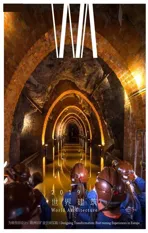乌拉尔山的矿业遗产:自助设计、衰败与荒地,乌拉尔联邦管区,俄罗斯
2019-10-17娜杰日达索洛宁娜奥尔加希皮齐娜叶连娜科丘霍娃卡罗拉诺伊格鲍尔TextbyNadezhdaSoloninaOlgaShipitsynaElenaKochukhovaCarolaNeugebauer
娜杰日达·索洛宁娜,奥尔加·希皮齐娜,叶连娜·科丘霍娃,卡罗拉·S·诺伊格鲍尔 文/Text by Nadezhda Solonina, Olga Shipitsyna, Elena Kochukhova, Carola S. Neugebauer
尚晋 译/Translated by SHANG Jin
乌拉尔山的矿业遗产体现出一种深刻的尺度和历史。它可以上溯到17 世纪,那时沙皇彼得大帝下令开采矿床(磁铁矿、铜矿、金矿等)[1],并在该地区施行城市化。到20 世纪初已开设了300 多座冶炼厂。苏联时期对这些工厂进行了现代化改造,并在该地区与新的单一型城市一同建立了新的工厂。1991 年,苏联的解体让一切天翻地覆,举步维艰:矿井和工厂或是缩减生产或是关停,失业率居高不下。有些企业实现了成功的私有化和现代化。于是就造成了今天空间和社会的两极分化:一方面是欣欣向荣的地区首府叶卡捷琳堡1)(图1、2),另一方面是大量人口萎缩、以单一行业为经济基础的小型工业城市。
在这一背景下,利益攸关的当地人满怀热情,将矿业遗产视为该地区向后工业社会转型的一个巨大潜力。不过,到目前为止,这种热情是不成体系的,缺乏政治保障和财政投入。现实中的“后矿业设计”包含了当地未能实现的愿景、自助行动和衰败之美。下面的“后矿业设计”实例可以为此证明。
(1)衰败与荒地之美正是乌拉尔山许多矿井、矿坑和矿渣堆的“设计”所在。尽管将原有厂房和煤矿的建筑单体通过再利用改造成博物馆也是乌拉尔地区的常见做法(如塞维尔斯基博物馆,图3-5),整个矿业建筑群的再开发方式却尚不明晰。相反,这些遗址表现出衰败和荒地迷人的“设计”,吸引着追求极致的游客和专家(如杰格佳尔斯克矿井,图6、7,或斯塔劳特金斯基冶炼厂,图8、9)。它们只有最简单的旅游基础设施,比如观景台(如已关闭的戈罗布拉戈达茨基铜矿,图10-12)。即使是国有的露天博物馆,有时也不对游客开放,就像下塔吉尔2)——这个具有历史价值的遗址将过去300 年的技术发展历程汇于一地,却缺少保护高炉的投资(图13-15)。
(2)公众参与加上企业家思维,是当地将后矿业遗址改造为教育、探险和文化场所的许多项目的基础。它产生的是自助设计。
贝雷佐夫斯基市3)的“莎塔”博物馆是大众民俗设计(图16-18)的一个例子。这家已经成功运行10 余年的博物馆,起源于当地企业家瓦列里·洛巴诺夫的个人倡议:他希望让城市悠久的采金历史焕发生机。由于城市管理部门不支持他开设“互动博物馆”的想法,洛巴诺夫租用了1960 年代的旧训练矿,在排水清洁之后,按民俗风格复原了它。
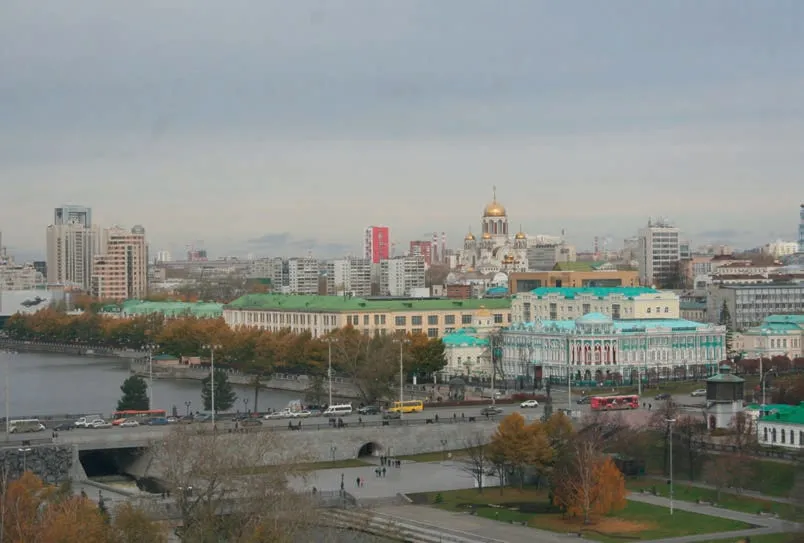
1 乌拉尔山脉的许多城市都回到了利用水力的采矿业。因此大坝经常位于城市中心,叶卡捷琳堡也是如此/Many cities in the Ural Mountains go back to mining that used the power of water. The dam is thus very often in heart of the cities, also in Ekaterinburg
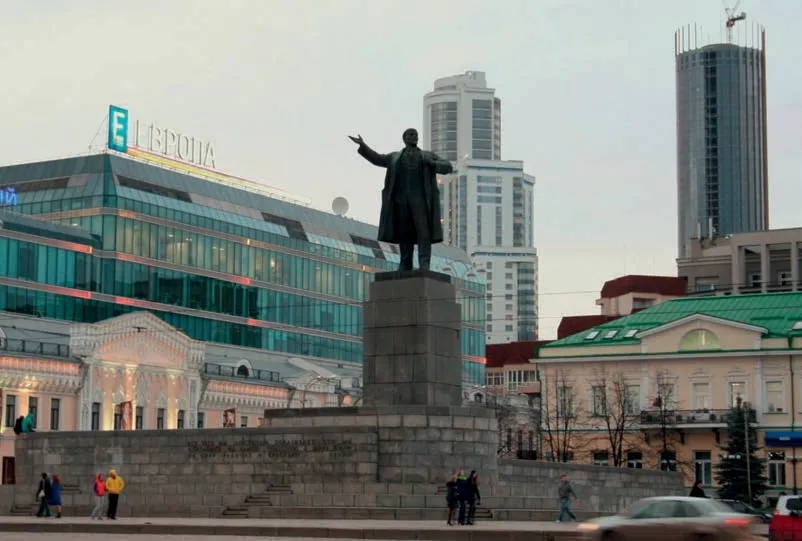
2 叶卡捷琳堡是一个蓬勃发展的后矿业城市/Ekaterinburg - a booming post-mining city(1.2图片来源/Sources: Carola S.Neugebauer)
Mining heritage in the Ural Mountains displays an impressive scale and history. It dates back to the 17 century, when Tsar Peter the Great launched the exploitation of the ore deposits (magnetic iron ore,copper, gold, etc.)[1]and the region's urbanisation.Until the beginning of the 20 century, more than 300 metallurgical plants opened. In Soviet times,the plants were modernised and new factories found along with new mono-cities in the region. The collapse of the Soviet Union in 1991, triggered fundamental changes and hardship: Mines and factories reduced their production or closed down, resulting in high unemployment. Some enterprises underwent successful privatisation and modernisation. As a result, we witness today the polarisation of space and society: The booming regional capital of Ekaterinburg1)(Fig. 1, 2) on the one hand and many small industrial cities of shrinking population and mono-sectoral economic base, on the other.
Against this backdrop, enthusiastic local stakeholders consider the mining heritage as one important potential for the region's transition towards a post-industrial society. So far, however, this enthusiasm is splintered, lacking political commitment and financial investment. Actual "post-mining designs"range between unfulfilled local visions, do-it-yourself and the beauty of decay. The following examples of"post-mining designs" may illustrate that.

3-5 塞维尔斯基博物馆/Seversky Museum(3-5图片来源/Sources: Natalia Borozdina)
除了这种项目之外,当地的行动主义也带来了后矿业建筑改造更多全面却未能实现的愿景。目前的一个例子是瑟谢尔季4)城市中心项目。当地企业家扬·科然成立了“瑟谢尔季发展代理公司”,并邀请叶卡捷琳堡的建筑师为带有旧水坝和冶炼厂的城市中心复兴提出基本理念。后者被列为遗迹,却完全废弃,未来将改造成一个文化中心 (图19-22)。如今,当地的行动和市长在为(地区或国家的)政府资金努力。
这几个例子指出了乌拉尔矿业遗产的历史价值与糟糕的保护利用状况之间的尖锐矛盾。2010 年以来,每个秋季的乌拉尔当代艺术工业双年展都试图让更广泛的公众意识到这一点。□

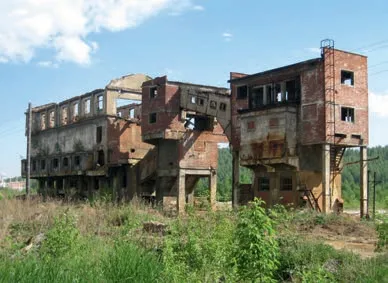
6.7 杰格佳尔斯克矿井——废弃的行政大楼、车间和锅炉房/Degtyarsky copper mine - The abandoned buildings of administration, workshops and boiler room(6.7摄影/Photos:Natalia Borozdina)


8.9 斯塔劳特金斯基冶炼厂/Staroutkinsky metallurgical plant(8.9摄影/Photos: Dmitry Khanin)
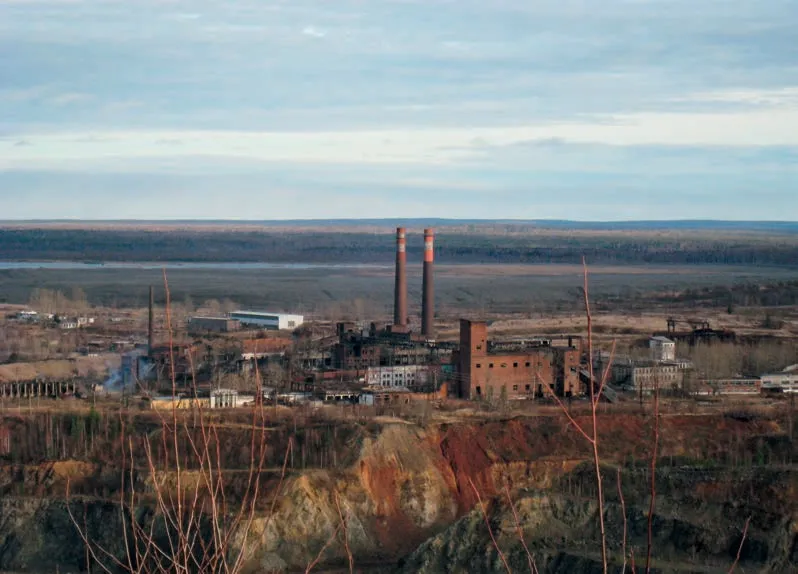
10 戈罗布拉戈达茨基铜矿烧结厂废墟/The ruins of sinter plant, copper mine Goroblagodatsky
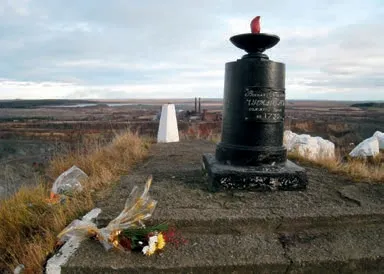
11 戈罗布拉戈达茨基铜矿采石场边的观景台与纪念品/The observation platform on the side of quarry with memorial,copper mine Goroblagodatsky
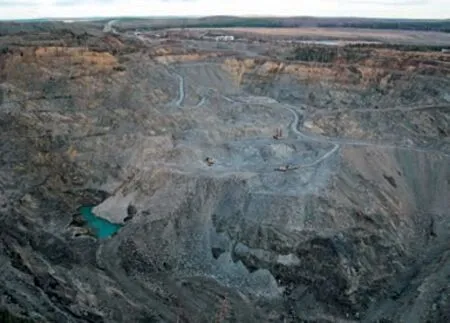
12 戈罗布拉戈达茨基铜矿中央坑/The central pit of Goroblagodatsky mine(10-12摄影/Photos: Leonid Desyatov)
(1) The beauty of decay and wilderness is the"design" of many mines, pits and spoil heaps in the Ural Mountains. While the reuse of single buildings of former plants and collieries as museums is a common practice for in the Ural too (e.g. the Seversky Museum, Fig. 3-5), the redevelopment of whole mining complexes is not yet obvious. The sites rather display fascinating "designs" of decay and wilderness attracting extreme tourists and experts (e.g. the Degtyarsky mine, Fig. 6, 7; or the Staroutkinsky metallurgical plant, Fig. 8, 9). They rarely have minimal touristic infrastructures such as viewing platforms etc. (e.g. the closed copper mine Goroblagodatsky, Fig. 10-12). Even state-owned open-air museums are sometimes not accessible for visitors like in Nizhny Tagil2)- a historically valuable site showing the technological developments of the last 300 years in one place, but lacking investments to safeguard the blast furnace (Fig. 13-15).
(2) Civic engagement, combined with entrepreneurial thinking, is the base of several local projects to transform post-mining sites into places of education, adventure and culture. It results in Do-It-Yourself designs.
The museum "Shahta" in the city of Berezovsky3)is an example of popular folk design (Fig. 16-18).Working successfully for more than 10 years, this museum goes back to private initiative of the local entrepreneur Valery Lobanov, who wanted to bring to life the city's longstanding history of gold mining.Since the city administration did not support his idea to open an "interactive museum", Lobanov rented a former training mine of the 1960s, drained,cleaned and restored it in folklore style.
Apart from such projects, local activism also comes up with more comprehensive, yet unfulfilled visions for post-mining transformations. A current example is the project for the city centre of Sysert4).The local entrepreneur Yan Kozhan found the"Sysert Development Agency" and invited architects from Ekaterinburg to develop a first concept for the revitalisation of the city centre with the historic dam and a metallurgical plant. The latter is attempted as monument, but was totally abandoned and should become a cultural centre (Fig. 19-22). Now, the local initiative and mayor are striving for public (regional or national) funding.
These few examples point to the painful tension between the historic value of the Ural mining heritage and its deplorable state of preservation and use. Since 2010 in every autumn, the Ural Industrial Biennale of Contemporary Art seeks to sensitise a broader public for this.□

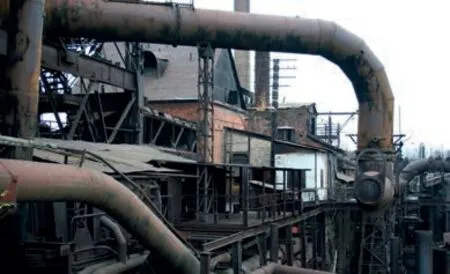
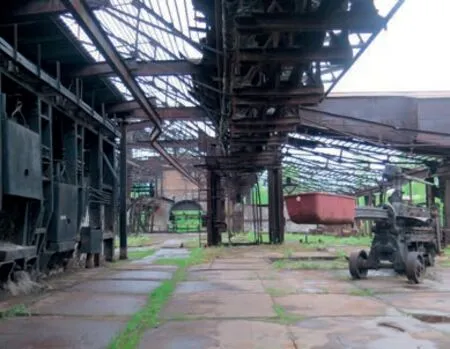
13-15 下塔吉尔/Nizhny Tagil(13-15图片来源/Sources: Carola S. Neugebauer)
注释/Notes
1)乌拉尔中部(斯维尔德洛夫斯克州)最大的城市,人口1,468,833。/Largest city in Central Ural (federal subject Sverdlovsk Oblast), 1,468,833 inhabitants.
2)乌拉尔中部(斯维尔德洛夫斯克州)第二大城市,人口353,950。/Second largest city in Central Ural (federal subject Sverdlovsk Oblast), 353,950 inhabitants.
3)叶卡捷琳堡旁的城市,人口57,192。/A city of 57,192 inhabitants close to Ekaterinburg.
4)叶卡捷琳堡旁的城市,人口20,962。/A city of 20,962 inhabitants next to Ekaterinburg.
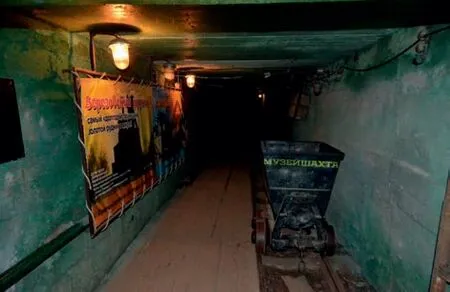
16 “莎塔”博物馆的窄轨铁路和矿石运输小车/Narrow-gauge railway and trolley for ore transportation in the "Shahta"

17 新博物馆博览会:参观者可以与展品互动/New museum exposition: visitors can interact with objects

18 新博物馆博览会:俄罗斯帝国使用监狱劳力提取黄金。该图说明了这种情况/New museum exposition: In the Russian empire for the extraction of gold used labor prisoners.The exposition and the figure here illustrates this situation(16-18图片来源/Sources: the mine Museum)

19 振兴瑟谢尔季市中心的设计理念,以大坝和大坝左侧的工厂这些采矿遗产为标志/Design concept for the revitalisation of the Sysert city centre, marked by the legacies of mining - the dam and the plant on the left of the dam(图片来源/Sources:Architectural group U.R.A.L. Render provided by Evgeniy Volkov)
评论
章明:一个简单的设计评论并不能涵盖乌拉尔山的矿业遗产,其呈现出了工业遗产或者说既有工业区在后工业时代面临迭代更新时普遍存在的问题。在缺乏政策支持和持续、稳定资金来源的情况下,建议遵循荒地之美,向着“遗迹花园”的方向发展。可以选取一个特殊点进行更新改造,作为整个区域的接待中心和展陈介绍,和“荒地”形成对比。同时,在改造过程中应保证建筑与环境的安全性。
龙灏:想象一下,如果身处文中那些衰败、苍凉、悠远以及尺度惊人的工业遗迹中间,会有怎样的震惊与感叹?悠久的采矿历史和苏联传统工业可以带来的特殊美学体验显然是这些遗址未来发展的巨大机会。然而遗憾的是,俄罗斯当代的经济现状使得仅仅依靠个人的努力所实现的低水平利用,显然尚不足以体现这些遗址在后工业时代的文化潜力,现有的“文化中心”开发意向也并未挖掘出这些遗址在评论者看来应具备的特殊美学价值。当然,名为“乌拉尔当代艺术工业双年展”中的“工业”二字,不仅凸显了这一地区的文化特色,也带来了对这些遗址未来发展愿景的某种期待。

20 被废弃的工厂建筑北立面/View on the abandoned plant building, north façade(摄影/Photo: Evgeniy Volkov)

21 设计概念:新生的巴若夫山。工厂建筑北立面/Concept -the Bazhov hill after revitalization. View on the plant building,north façade(图片来源/Sources: Architectural group U.R.A.L. Render provided by Evgeniy Volkov)
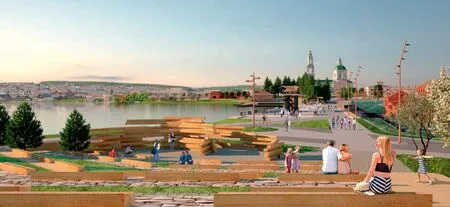
22 设计概念:城市池塘和大坝景观,右侧是工厂西立面/Concept - view of the city pound and dam, on the right - the western façade of the plant(图片来源/Sources: Architectural group U.R.A.L. Render provided by Evgeniy Volkov)
Comments
ZHANG Ming: Mining Heritage in the Ural Mountains cannot be briefly judged by its design, for it reveals the general problems industrial heritage or existing industrial districts would face in the postindustrial era. Under the situation of lacking political support and continuous and stable financial sources,it is suggested that the mining heritage in the Ural Mountains should follow its beauty of decay and develops itself into a "garden of ruins". Meanwhile, it is also implied to choose one spot for regeneration,which works as the reception and display area for the entire region and forms strong contrast with the"deserted place". Besides, during the regeneration process, security of architecture and environment should be emphasized.
LONG Hao: Just imagine, standing at the foot of those desolate, pale and remote industrial monuments with their staggering scale as described in the text - what a shocking amazement! The aesthetic experiences that a long mining history and traditional Soviet industry can bring obviously introduce immense opportunities to these sites'development in the future. Yet regrettably,contemporary Russian economic conditions allow only low level use through personal efforts, which is apparently an understatement of these sites' cultural potentials in the post-industrial era. The current"Cultural Centre" development proposal has yet to explore the distinct aesthetic values that these sites deserve as the critic sees. Certainly the word"industrial" in the title "Ural Industrial Biennale of Contemporary Art" not only highlights the cultural identity of this area, but raises certain expectations about the vision of future developments for these places. (Translated by SHANG Jin)
